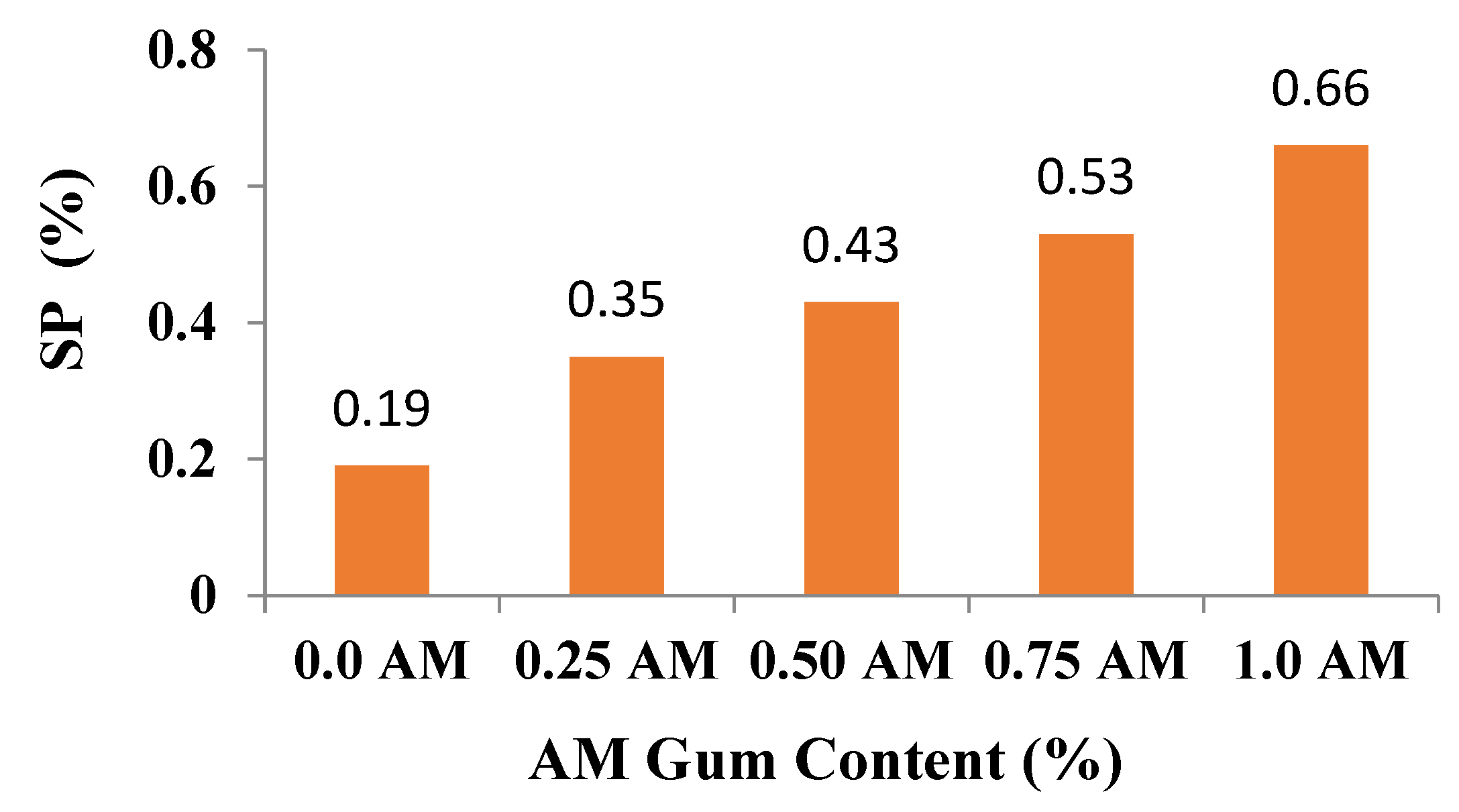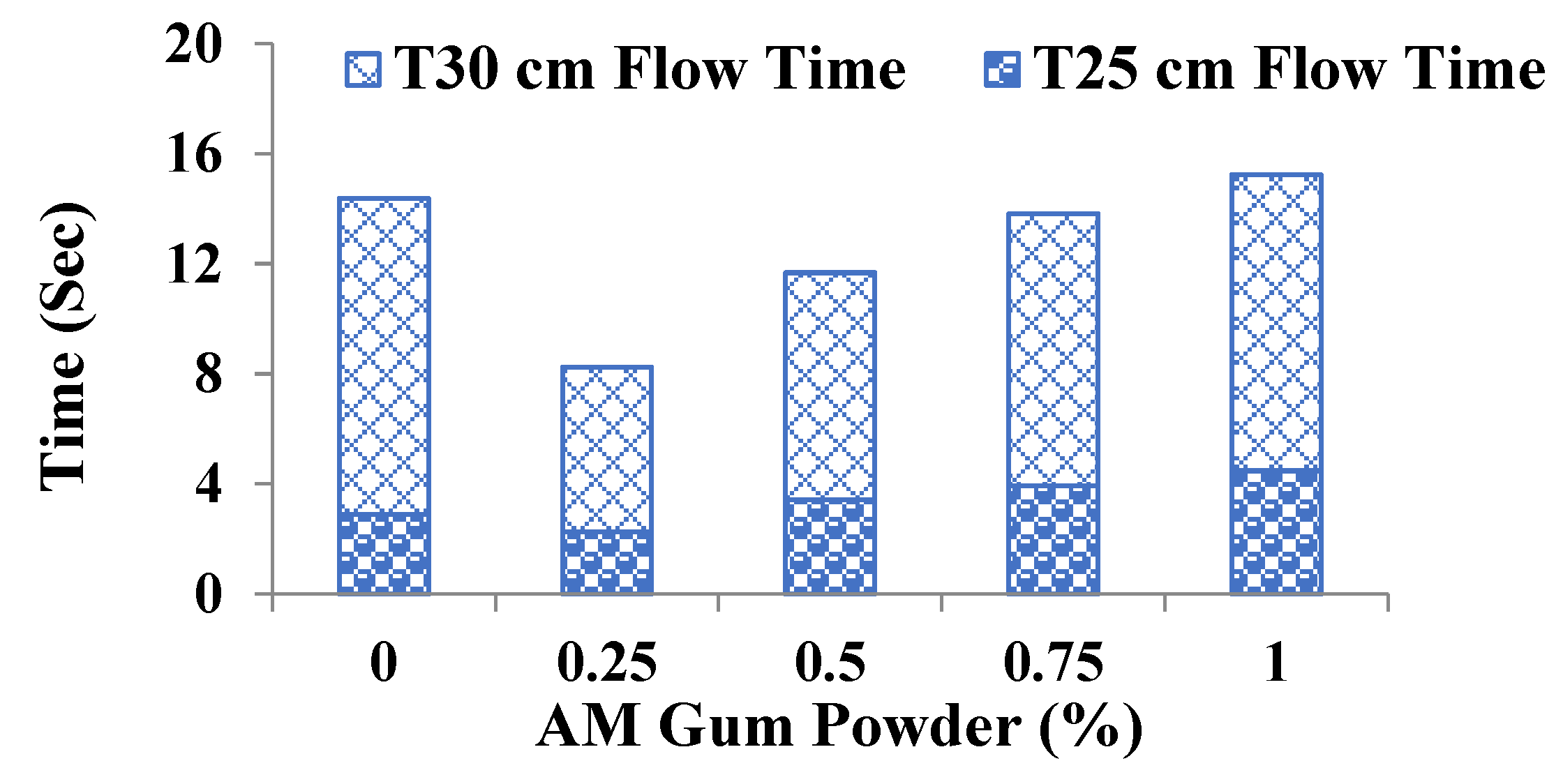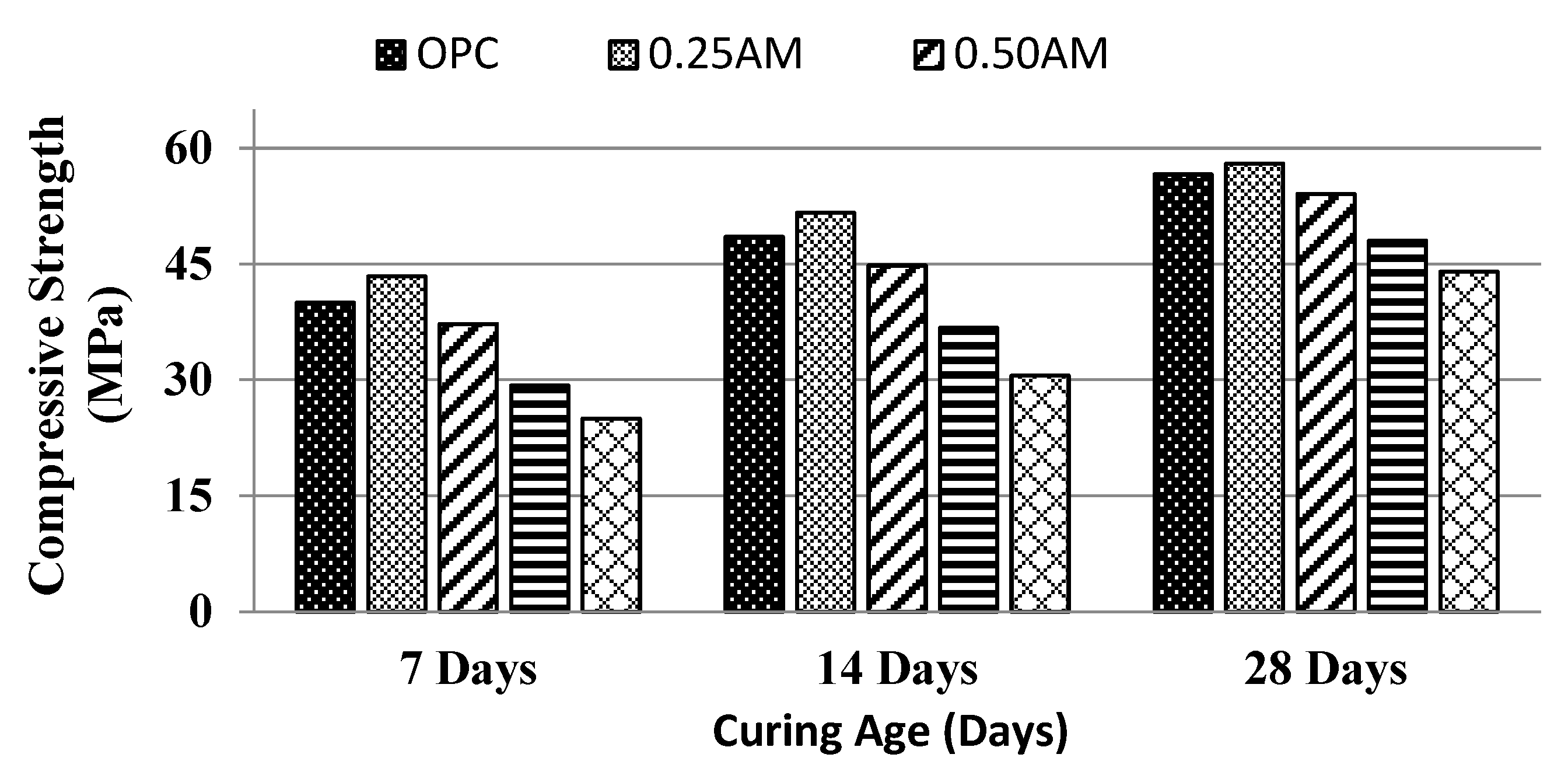Utilization of Acacia Modesta Gum Powder as Viscosity-Modifying Agent in Self-Compacting Paste Systems †
Abstract
1. Introduction
2. Experimental Program
2.1. Raw Materials
2.2. Mixing Regime
2.3. Testing
- Superplasticizer demand determination using Hagerman’s mini-cone slump apparatus;
- Viscosity measurement using Hagerman’s mini-slump cone test and rheometric investigation test;
- Fresh tests (air content and fresh density test);
- Hardness tests (hardened density and compressive strength test).
3. Results and Discussion
3.1. SP Demand of SCPs Containing AM Gum Powder
3.2. Viscosity of SCPs Containing AM Gum Powder
3.2.1. Viscosity Using Hagerman’s Mini-Cone Flow Test
3.2.2. Apparent Viscosity using Rheometer
3.3. Fresh Properties of SCPs Containing AM Gum Powder
3.3.1. Air Content
3.3.2. Fresh Density
3.4. Hardness Properties of SCPs Containing AM Gum Powder
3.4.1. Hardened Density
3.4.2. Compressive Strength
4. Practical Implementations
5. Conclusions
- Super-plasticizer demand of the SCPs containing AM gum powder increases with the increase in the amount of AM gum powder due to nature (rough texture) and chemical composition of AM gum powder.
- Viscosity of the SCPs increases with the increase in the amount of AM gum powder, indicating that it has the potential to act as viscosity-modifying agent.
- Fresh tests of SCPs containing AM gum powder indicate that AM gum powder has the potential to act as air-entraining agent as the air content increases and fresh density decreases with the increase in the amount of the AM gum powder.
- Hardness tests of SCPs containing AM gum powder indicate that it degrades the compressive strength; however, this strength degradation can be mitigated by using the average particle sizes closer to the size of the cement. About 2.5% improvement in compressive strength with 0.25% AM gum content is a clear indication of this aspect as it improves the fresh paste and hardens the densities of SCPs.
Author Contributions
Funding
Institutional Review Board Statement
Informed Consent Statement
Data Availability Statement
Conflicts of Interest
References
- Mebrouki, A.; Belas, N.; Bouhamou, N.-e. Experimental plans method to formulate a self-compacting cement paste. Mater. Technol. 2010, 44, 13–20. [Google Scholar]
- Revilla-Cuesta, V.; Faleschini, F.; Skaf, M.; Ortega-López, V.; Manso, J.M. Balancing sustainability, workability, and hardened behavior in the mix design of self-compacting concrete. In Handbook of Sustainable Concrete and Industrial Waste Management; Woodhead Publishing: Duxford, UK, 2022; pp. 333–358. [Google Scholar] [CrossRef]
- Rizwan, S.A.; Gul, S.; Bier, T.A. Self-Consolidating Paste Systems Containing Acacia Nilotica Gum Powder. ACI Mater. J. 2019, 116, 5–14. [Google Scholar] [CrossRef]
- Rizwan, S.A.; Mahmood, N.; Mahmood, U.; Bier, T.A. Response of self-compacting paste (SCP) systems containing Acacia Modesta gum. Constr. Build. Mater. 2018, 161, 398–406. [Google Scholar] [CrossRef]
- Rizwan, S.A.; Latif, W.; Bier, T.A. Response of self-consolidating cement paste systems containing Acacia Nilotica Gum as an organic admixture. Constr. Build. Mater. 2016, 126, 768–776. [Google Scholar] [CrossRef]
- Montenegro, M.A.; Boiero, M.L.; Valle, L.; Borsarelli, C.D. Gum Arabic: More than an edible emulsifier. Prod. Appl. Biopolym. 2012, 51, 953–978. [Google Scholar]
- Obaid, S.S. The medical uses of Gum Acacia-Gum Arabic (GA) in human. Acad. J. Res. Sci. Publ. 2020, 1, 1–11. [Google Scholar]
- Jamila, N.; Khan, N.; Hwang, I.M.; Saba, M.; Khan, F.; Amin, F.; Khan, S.N.; Atlas, A.; Javed, F.; Minhaz, A. Characterization of natural gums via elemental and chemometric analyses, synthesis of silver nanoparticles, and biological and catalytic applications. Int. J. Biol. Macromol. 2020, 147, 853–866. [Google Scholar] [CrossRef]
- Massey, S.; MacNaughtan, W.; Williams, H.E.; Wolf, B.; Iqbal, M.S. A structural study of Acacia nilotica and Acacia modesta gums. Carbohydr. Polym. 2017, 175, 207–215. [Google Scholar] [CrossRef]
- Bahmani, H.; Mostofinejad, D. Microstructure of ultra-high-performance concrete (UHPC)—A review study. J. Build. Eng. 2022, 50, 104118. [Google Scholar] [CrossRef]
- Rizwan, S.A. High-Performance Mortars and Concrete Using Secondary Raw Materials. Ph.D. Thesis, TU Bergakademie Freiberg, Freiberg, Germany, 2006. [Google Scholar]
- Pang, L.; Liu, Z.; Wang, D.; An, M. Review on the Application of Supplementary Cementitious Materials in Self-Compacting Concrete. Crystals 2022, 12, 180. [Google Scholar] [CrossRef]
- Usman, M.; Khan, A.Y.; Farooq, S.H.; Hanif, A.; Tang, S.; Khushnood, R.A.; Rizwan, S.A. Eco-friendly self-compacting cement pastes incorporating wood waste as cement replacement: A feasibility study. J. Clean. Prod. 2018, 190, 679–688. [Google Scholar] [CrossRef]
- Navarrete, I.; Kurama, Y.; Escalona, N.; Brevis, W.; Lopez, M. Effect of supplementary cementitious materials on viscosity of cement-based pastes. Cem. Concr. Res. 2021, 151, 106635. [Google Scholar] [CrossRef]
- Khayat, K.H. Viscosity-enhancing admixtures for cement-based materials—An overview. Cem. Concr. Compos. 1998, 20, 171–188. [Google Scholar] [CrossRef]
- ACI 318-14; Building Code Requirements for Structural Concrete (ACI 318-14): An ACI Standard; Commentary on Building Code Requirements for Structural Concrete (ACI 318R-14). American Concrete Institute: Farmington Hills, MI, USA, 2014.
- Mehta, P.K.; Monteiro, P.J. Concrete Microstructure, Properties and Materials, 4th ed.; McGraw Hill: New York, NY, USA, 2017. [Google Scholar]
- Bessaies-Bey, H.; Khayat, K.H.; Palacios, M.; Schmidt, W.; Roussel, N. Viscosity modifying agents: Key components of advanced cement-based materials with adapted rheology. Cem. Concr. Res. 2021, 152, 106646. [Google Scholar] [CrossRef]
- de Matos, P.R.; Sakata, R.D.; Gleize, P.J.P.; de Brito, J.; Repette, W.L. Eco-friendly ultra-high performance cement pastes produced with quarry wastes as alternative fillers. J. Clean. Prod. 2020, 269, 122308. [Google Scholar] [CrossRef]
- ASTM C150; Standard Specification for Portland Cement. ASTM International: West Conshohocken, PA, USA, 2022. [CrossRef]
- Fares, G.; Al-Negheimish, A.; Alhozaimy, A.M.; Khan, M.I. Polycarboxylate superplasticizer and viscosity modifying agent: Mode of addition and its effect on cement paste rheology using image analysis. J. Build. Eng. 2022, 48, 103946. [Google Scholar] [CrossRef]
- Pei, R.; Liu, J.; Wang, S. Use of bacterial cell walls as a viscosity-modifying admixture of concrete. Cem. Concr. Compos. 2015, 55, 186–195. [Google Scholar] [CrossRef]
- Saak, A.W.; Jennings, H.M.; Shah, S.P. New methodology for designing self-compacting concrete. Mater. J. 2001, 98, 429–439. [Google Scholar]
- Chang, Y.; Hu, Y.; McClements, D.J. Competitive adsorption and displacement of anionic polysaccharides (fucoidan and gum arabic) on the surface of protein-coated lipid droplets. Food Hydrocoll. 2015, 52, 820–826. [Google Scholar] [CrossRef]
- Huang, F.; Li, H.; Yi, Z.; Wang, Z.; Xie, Y. The rheological properties of self-compacting concrete containing superplasticizer and air-entraining agent. Constr. Build. Mater. 2018, 166, 833–838. [Google Scholar] [CrossRef]
- Elinwa, A.U.; Abdulbasir, G.; Abdulkadir, G. Gum Arabic as an admixture for cement concrete production. Constr. Build. Mater. 2018, 176, 201–212. [Google Scholar] [CrossRef]
- Mbugua, R.; Salim, R.; Ndambuki, J. Effect of Gum Arabic karroo as a Water-Reducing Admixture in Concrete. Materials 2016, 9, 80. [Google Scholar] [CrossRef] [PubMed]




| Sr. No. | D50 (μm) | AM (%) | SP (%) |
|---|---|---|---|
| 1 | 28.3 | 0.00 | 0.19 |
| 2 | 135 | 0.25 | 0.35 |
| 3 | 135 | 0.50 | 0.43 |
| 4 | 135 | 0.75 | 0.53 |
| 5 | 135 | 1.00 | 0.66 |
| AM (%) | Air Content (%) | Fresh Density (g/cm3) | Hardened Density (g/cm3) |
|---|---|---|---|
| 0.0 | 1.5 | 2.34 | 2.11 |
| 0.25 | 2.2 | 2.36 | 2.13 |
| 0.50 | 3.1 | 2.33 | 2.09 |
| 0.75 | 3.7 | 2.28 | 2.05 |
| 1.0 | 3.9 | 2.23 | 2.02 |
Publisher’s Note: MDPI stays neutral with regard to jurisdictional claims in published maps and institutional affiliations. |
© 2022 by the authors. Licensee MDPI, Basel, Switzerland. This article is an open access article distributed under the terms and conditions of the Creative Commons Attribution (CC BY) license (https://creativecommons.org/licenses/by/4.0/).
Share and Cite
Malik, M.W.; Rizwan, S.A. Utilization of Acacia Modesta Gum Powder as Viscosity-Modifying Agent in Self-Compacting Paste Systems. Eng. Proc. 2022, 22, 15. https://doi.org/10.3390/engproc2022022015
Malik MW, Rizwan SA. Utilization of Acacia Modesta Gum Powder as Viscosity-Modifying Agent in Self-Compacting Paste Systems. Engineering Proceedings. 2022; 22(1):15. https://doi.org/10.3390/engproc2022022015
Chicago/Turabian StyleMalik, Muhammad Waqas, and Syed Ali Rizwan. 2022. "Utilization of Acacia Modesta Gum Powder as Viscosity-Modifying Agent in Self-Compacting Paste Systems" Engineering Proceedings 22, no. 1: 15. https://doi.org/10.3390/engproc2022022015
APA StyleMalik, M. W., & Rizwan, S. A. (2022). Utilization of Acacia Modesta Gum Powder as Viscosity-Modifying Agent in Self-Compacting Paste Systems. Engineering Proceedings, 22(1), 15. https://doi.org/10.3390/engproc2022022015





